The tale of The Eloquent Peasant comes down to us from ancient Egypt by way of four different and incomplete documents – manuscript as well as ostrica. It is a lovely poem, written in classical Middle Egyptian, composed around 2100 BC . From these remnants most of the document has been pieced together and, as most probably was the case in ancient Egypt, the text is one of the earliest documents read by aspiring Egyptologists and, in ancient times, aspiring scribes. It is an excellent text both in terms of its relative simplicity as well as containing an important – and timeless – moral story.
Based on one of the major literary texts survived from the Middle Kingdom, the classical period of Egyptian literature, The Eloquent Peasant is a combination of a morality/folk tale and a poem. The events are set between 2160 and 2025 BC. When the peasant Khun-anup and his donkey stumble upon the lands of the noble Rensi, the peasant’s goods are confiscated and he’s unjustly accused of theft.
The peasant petitions Rensi who is so taken by the peasant’s eloquence that he reports his astonishing discovery to the king. The king realises the peasant has been wronged but delays judgement [so he] can hear more of his eloquence. The peasant makes a total of nine petitions until finally, his goods are returned.
Source – World Cinema Foundation
Notes on the restoration
The Eloquent Peasant has been restored using the original 35mm camera and sound negatives preserved at the Egyptian Film Center in Giza. The digital restoration produced a new 35 mm internegative. Special thanks to the Bibliotheca Alexandrina.
Source – THE ELOQUENT PEASANT (Shakavi el Flash el Fasi, Egypt/1969). Written by Shadi Abdel Salam.
… [The video] is a gesture towards the humanity of the original — a reminder that the poem was written by an individual for his contemporaries (and not for Egyptologists). This may even be the first time that an Egyptological commentary on a literary text has included a photograph of a living person. And this living and subtle work of art gained new resonance with the Egyptian revolution of 2011.
As author Ahdaf Soueif noted then, it represents an Egyptian tradition of non-violent protest against any abuse of authority, and it is, in the words of Shadi Abd el-Salam, ‘a cry for justice, a cry that persists throughout the ages’.’
Source –Reading an ancient Egyptian poem, by
Richard Parkinson, curator, British Museum
To the left of this blog you will see the copy of a small ostracon, from the Deir el-Medina , I believe, which shows the efforts of a beginning scribe-student practicing his hieroglyphic signs.
In our study of ancient Egyptian at Berkeley, we used the transcribed text found in Adrien De Buck’s Egyptian Reading Book Vol I Leiden 1948. It is available on SCRIBD.
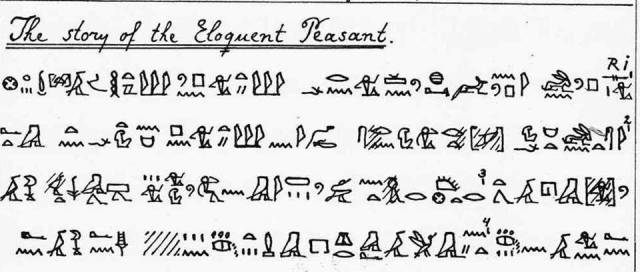
The beginning of the story (reads right to left), as transcribed by De Buck. Source – De buck, Reading Book
The story pits a lowly cultivator – a peasant – against a nefarious member of the of the ruling class who wishes to steal the market goods of the peasant Hunanup. The beginning of the tale >
There was a man, Khun-anup by name, a peasant of
Sechet-hemat [Wadi Natrun], and he had a wife, ////// by name.Then said this peasant to his wife: “Behold, I am
going down to Egypt to bring back bread for my
children. Go in and measure the grain that we still
have in our storehouse, ////////// bushel.” Then he
measured for her eight bushels of grain. Then this
peasant said to his wife:“Behold, two bushels of grain shall be left for bread for you and the children.
But make for me the six bushels into bread and beer
for each of the days that I shall be on the road.”
Then this peasant went down to Egypt after he had
loaded his asses with all the good produce of Sechethemat.
The remainder of the tale in english, which I’ve reproduced from the site of Reshafim, can be found here.
Bread and beer were the key elements of nutrition in ancient Egypt – and it is therefore no surprise that he focusses on grain by which to make these, both for himself on the road and for his wife and children. I’ve put in bold lettering [english, above] these key ingredients in the story.
The story is just as meaningful today, and has been translated into egyptian and also a very nice movie has been made of it.
الحدوتة
كان یاماكان في مصر زمان راجل فلاح اسمھ “خنوم”، فلاح من “غیط الملح”، متجوز واحدة اسمھا ماري.
وف یوم من الأیام “خنوم” قال لمراتھ:
– اسمعي. أنا طالع مصر اجیب قوت العیال. قومي یا للا
ع الجرن. كیلِّي اللي فاضل فیھ من شعیر السنة اللي فاتت.
مراتھ عملت كده. قام خنوم قال لھا:
– بصي. العشرین قدح دول عشانك انتي والعیال. والستة اللي باقیین اخبزي لي منھم، وخّمري حبة بیرة
لزوم السفر.
وطلع الفلاح علي مصر.
طلع الفلاح علي مصر، بعد ما حِّمل حمیره بكل اللي طایلاه إیده من خیر غیط الملح. كانت شیلة كبیرة، إشي
ملح وإشي نطرون وأعشاب یاما تشفي العلیل وترد الروح، وإشي جلد ضباع وفرو نمور، وحمام وطیور.
حاجات ما تتعدش.
The remainder of the story in arabic can be found here.
The movie was made several decades ago; and received several prizes. The use of literary arabic by the peasant provides an authentic turn. But you don-t have to understand arabic to appreciate the film and its moral.
If you now would like to learn more about hieroglyphs, here is a good place to begin – resources related to the wonderful site of EEF:
EEF-Glyphs and Grammars, Part I: Resources for beginners [Egyptologists’ Electronic Forum (EEF) and the Ancient Egyptian Language list (AEL).]
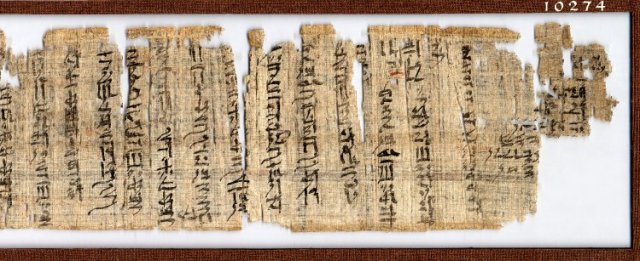
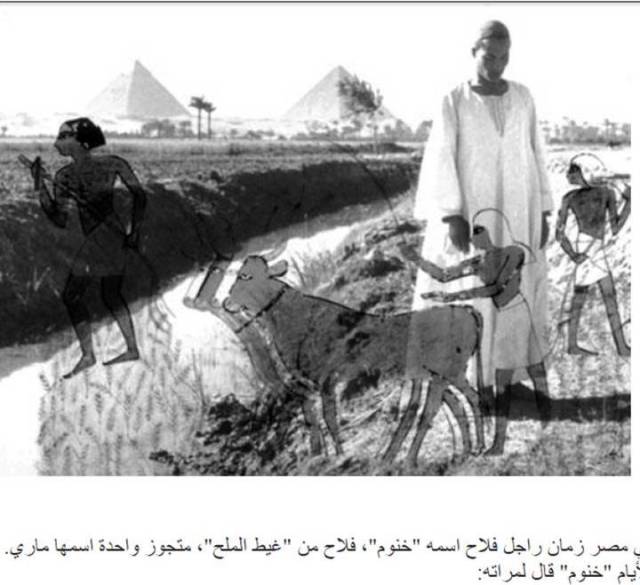





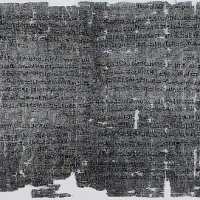
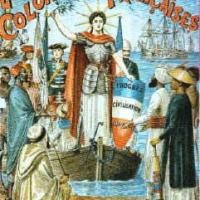
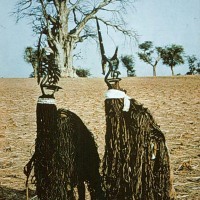
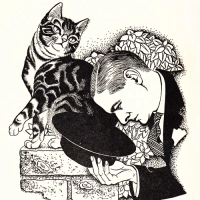


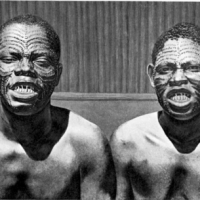
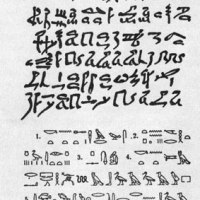













you do not speak a bout me or… 🙂
LikeLike
Sorry! I did not see your blog/address – very nice blog, and I will incorporate data on your work as soon as possible! Merci.
LikeLike
ohhhhhh thank you that s great and if you want to chang from wordpress to your won site like dianabuja.com i can offer this for you by any way we are neaber or 🙂
it is make me also pleauser as i would love to do some thing for hall Africia what you think?
LikeLiked by 1 person
You have been nominated for the One Lovely Blog Award:
http://griotgramgeneaography.blogspot.com/2014/09/one-lovely-blog-award.html
LikeLiked by 1 person
Merci, Victori! I am emailing you!
LikeLiked by 1 person